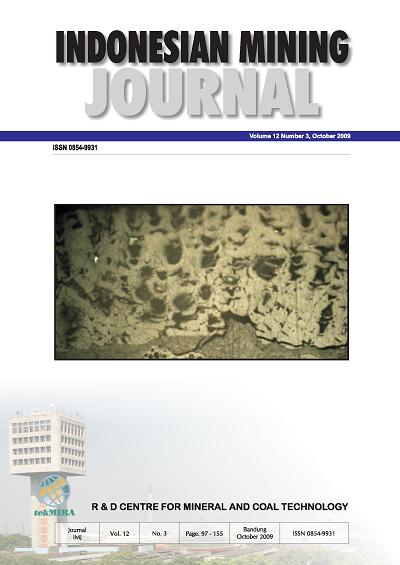Indexed by:
Vol. 12 No. 3 (2009): INDONESIAN MINING JOURNAL Vol. 12 No. 3 October 2009

Common issues on the mineral and coal mining sector in Indonesia are mainly caused by the centralistic policy instruments and the regional autonomous principles, which are not accommodated yet by the central government. Moreover, the rate of the mining investment is low due to the inconsistent regulations, particu- larly relating to the management aspects for the forest sector, spatial uses, environment and the central- regional authority sharing. Interest conflicts of using land, security, illegal mining cause the mining invest- ment that is very low. Accordingly, supply of the products of the mineral and coal commodities for the domestic needs automatically decline.
The objectives of establishing the new law (Law number 4 year 2009 about the mineral and coal mining) for the mineral and coal mining, hopefully, can manage the policy of exploitation of the resources, which can anticipate the opportunity and the challenge in the more prosperous future in this sector. In addition, this new law can provide the law warranty and protection to the stakeholders/mining businessmen, so they have the opportunity to increase interest and investment values in the mining sector, which could optimally improve the national and regional revenues.
Six papers are interesting to be assessed, because they have indicated to support the implementation of the above new mining law; particularly for the first paper that focuses on small-scale mining. The small-scale mining has been debated by mining experts in this country. The mining has a strong correlation with illegal mining operation that is associated with disorderly mining practices. This reminds us on the case of tremen- dous environmental disaster in Bangka-Belitung (tin mining), Kalimantan (coal mining), and even in all areas in Indonesia (industrial mineral mining). The presence of the new mining law is really expected to be able to cope with those illegal minings. Analysis on the law reveals that the law requires to be clarified by imple- menting regulations that have not been issued. Hopefully, those regulations will be issued in the next year. Currently, commercial biodiesel production still applies sodium hydroxide solution as homogeneous catalyst, which has some disadvantages and cannot be reused and difficult on its separation from the product. So, an alternative catalyst is necessary to be sought to solve the problem. A solid catalyst from clay (montmorillonite) is possible to apply. Genesis of the coal macerals depends especially on the tectonic and geologic setting. The Jambi Subbasin that is the back-arc basin associated with the fluvial to deltaic environments results in both rich in vitrinite and inertinite contents. These macerals are associated with the lithotypes. Maceral composi- tion of the coals shows an extreme phenomenon, because most of the Sumateran coals contain very low inertinite content with very high vitrinite content. A couple of years ago, a regulation on conversion of kerosene as subsidized fuel to alternative fuel for tobacco drying industry in NTB Province was issued. Coal as an alternative fuel has a significant role in the conversion process, which has smoothly been implemented because of the advantageous condition. Thousands tons of coal has been consumed, and this results in the saved subsidy. Upgraded brown coal water mixture (UBCWM) can be used as direct fuel as substitute for heavy fuel oil in industrial boilers. The addition of additive as dispersant is required to obtain a UBCWM with high coal concentration and low apparent viscosity as well as good flow characteristics. The research of this project was conducted by preparing UBCWM with the addition of polymethacrylate (PMA) and carboxym- ethyl cellulose as stabilizer. The results indicate that the addition of PMA in the production of UBCWM is effective as dispersant. Flotation of galena ore using aerofloat 241 was carried out. The sample used for the research is lead ore composed of minerals of galena, pyrite, sphalerite and quartz in order to increase lead content in the concentrate using flotation method. The result indicates that the flotation experiment using certain materials achieves maximum content of Pb in the concentrate with certain chemical compositions.
After assessing all the above papers, it is really expected that the certain new law will accommodate the golden bridge between R&D centre (supply aspect) and industries (demand aspect), which can synergize of the supply-demand on the mineral and coal commodities in accordance with the specific and characteristic products.
The Editor











